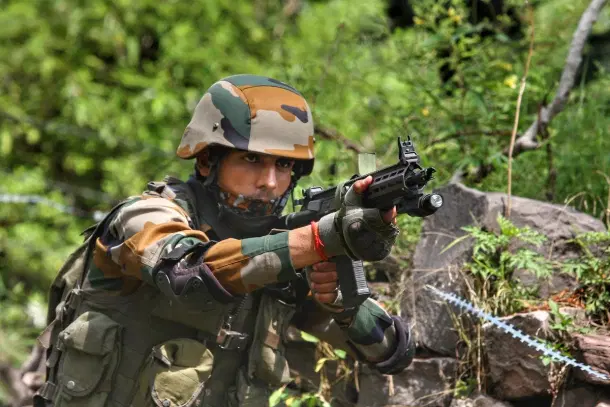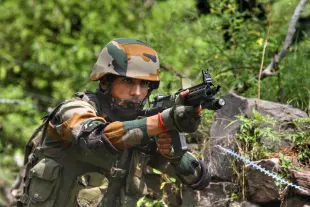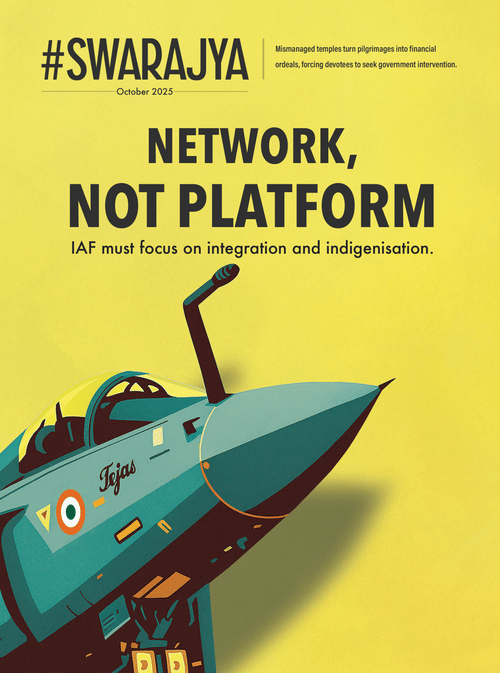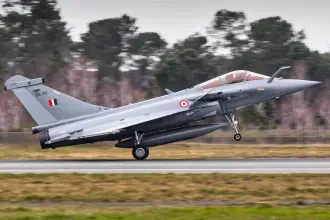Defence
Indian Army's Rifle Crisis Is A Mess Of Its Own Making
Prakhar Gupta
Aug 29, 2024, 03:16 PM | Updated Oct 03, 2024, 11:32 PM IST
Save & read from anywhere!
Bookmark stories for easy access on any device or the Swarajya app.


Almost every debate about defence modernisation in India starts and ends with experts berating the Ministry of Defence (MoD) for inordinate delays in procurement.
The military — the army in particular — is mostly spared. It is often seen as a victim of the civilian bureaucracy at the MoD and escapes scrutiny despite a critical role in the procurement process.
Make no mistake, the MoD babus deserve all the brickbats and then some for their Antony-esque incompetence.
The MoD's convoluted process of procurements, which former army chief General VK Singh (Retd) had once described as a "snakes and ladders game" in which there are "no ladders," is perhaps the most incorrigible obstacle to defence modernisation.
But the military is not blameless. Its penchant for drafting fantastical qualitative requirements (QRs) has repeatedly led to the acquisition of badly needed equipment being either delayed or aborted altogether, often after prolonged periods of technical evaluations and trials by the services.
In 2015, then defence minister Manohar Parrikar, describing the phenomenon at the India Today Conclave, said those writing the QRs were perhaps watching “Marvel comic movies," convincingly disguising his vexation as a jest. Former army chief General Bikram Singh, sitting next to him, quickly shifted the conversation back to the tardy procurement procedure, which is mostly a responsibility of the MoD. It was no surprise — the army's record on QRs is the worst among the three services.
In 2012, the then defence secretary had told the Parliamentary Standing Committee on Defence that as many as 41 of the army’s tenders had been withdrawn in the previous years due to "faulty and stringent General Staff Qualitative Requirements or GSQRs."
The QR Drafting Process
Drawing of QRs, which lay down the preliminary specifications of the equipment, begins after services receive responses to requests for information or RFIs issued to domestic or foreign vendors.
Often, information available in the brochures supplied by vendors is collected and the best of the capabilities are compiled as requirements. At times, this is done without mapping the capabilities or parameters to cost and stipulated timelines.
The draft document then moves up the chain of military command in the service headquarters, gathering new suggestions at every stage. In many instances, what emerges at the end is a "well-compiled wish list of utopian dimensions."
In some instances, QRs are tweaked in favour of a particular vendor — like in the case of Singapore Technologies' Pegasus 155 mm howitzer, which General V K Singh talks about in his autobiography Courage and Conviction.
As Finance Minister Nirmala Sitharaman noted in her 2020 budget speech, such cases often lead to single-vendor situations, which have been discouraged by Defence Procurement Procedures since 2005. This results in tenders being rescinded and acquisitions being endlessly delayed.
A Saga of Failures
The army has added to its already impressive list of QR blunders in recent years.
One such misstep has turned its quest to equip frontline troops with new snipers and rifles into an unending saga of failures, practically worth a novel on its own.
Take, for instance, the case of assault rifle procurement for replacing the troubled INSAS 5.56x45 mm rifles that entered service with the army in the mid-1990s.
In 2011, the army put out a global tender for multi-calibre assault rifles tenders. Initially, 66,000 of these had to be procured for a total requirement of around 7,50,000 rifles.
However, the army's imaginative QRs ensured the procurement hung in balance for over four years. It wanted a rifle with interchangeable barrels to allow the use of two completely different cartridges, the 5.56mm INSAS round for conventional warfare and the 7.62mm AK-47 round for counter-terror operations.
The "overambitious experiment" failed as no weapon could meet the requirement. The tender was scraped in 2015.
In 2019, the army contracted for 72,000 SIG716 rifles from USA’s Sig Sauer as a 'stop-gap' measure to equip frontline troops, with the option of adding another 72,000.
It was later reported that the rifles had been imported without the sights which make targeting easier, perhaps to keep the cost low and ensure that Sig Sauer emerged as the lowest bidder — a long and storied tradition.
Moreover, various operational glitches, including jamming, surfaced after the rifle was issued to troops.
For a while, it seemed the army had decided against placing a repeat order for these rifles. However, this week, the situation changed as an order for over 70,000 more SIG716 rifles was placed.
Meanwhile, the deal with Russia to licence-build 6,71,000 Kalashnikov AK-203 assault rifles in India made little progress due to disagreements over price and volume of localisation. Although a deal was reached in 2021, it managed to deliver only 35,000 rifles by July 2024, with only 10,000 handed over to troops.
Under the deal worth over Rs 5000 crore, 6.1 lakh AK-203 assault rifles are being made in India with technology transfer from Russia. The first 70,000 rifles are being produced with 5 per cent localisation, gradually increasing to 70 per cent, while the remaining rifles will be made with 100 per cent localisation.
At the current pace, the Russia-India joint venture might take years to deliver 6 lakh rifles, leaving the army with no solution in sight for its rifle woes and only itself to blame.
If not for its overly ambitious QRs in 2011, a new rifle could have been procured for the army in the first half of the last decade.
The procurement of sniper rifles has similarly become a never-ending tale of cancelled tenders.
Fanciful Futurism
It's often argued that services draft 'futuristic' QRs to prevent equipment from becoming obsolete quickly, but this reasoning is flawed for several reasons.
One, what services defend as 'futuristic' is, in many cases, fanciful or even absurd. This was amply demonstrated in the case of assault rifle procurement, in which even foreign vendors could not find solutions for the unrealistic requirements set by the army.
Two, the argument that any equipment inducted with contemporary capabilities will become obsolete within years completely disregards the role of iterative improvement and upgrade in ensuring combat platforms remain effective against evolving threats.
A Fair Chance for 'Make in India'
As Vivek Krishnan of SSS Defence, a small-arms maker based in Bengaluru pointed out in his now-viral social media post on the repeat order for Sig Sauer rifles, the army often uses the argument that Indian manufacturers are "not there on metallurgy” or their "designs are behind time” to reject indigenously-developed weapons.
While continuing with Sig Sauer might be justified for logistical reasons, the army's fixation on unrealistic QRs — resembling Marvel comic weapons — at the expense of Indian private sector players is indefensible.
For 'Make in India' to succeed in defence, the private sector needs more than talk — it requires a fair chance. The army must avoid sabotaging this with its QR blunders.
Prakhar Gupta is a senior editor at Swarajya. He tweets @prakharkgupta.





